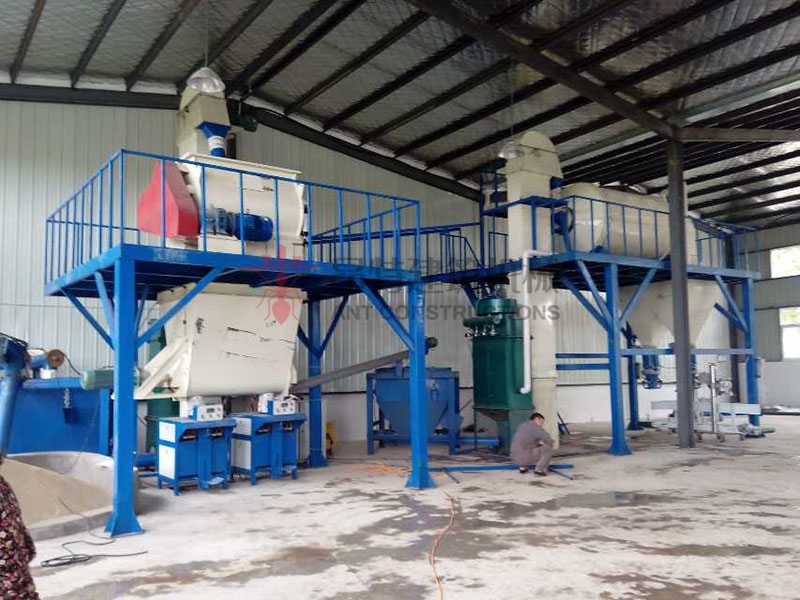Crack reasons on thermal insulation layer of eifs dry mortar
Author:ANT CONSTRUCTIONS Comefrom: Createdate:2020/11/15 14:59:49 Hits:63
Crack reasons on thermal insulation layer of eifs dry mortar

Cracks on the insulation layer of EIFs walls are a common phenomenon in current buildings, and it is also a difficult problem in construction. Poor handling will not only affect the insulation effect of the building, but also may lead to wall penetration and water leakage. Here below we analysis of the reasons of cracks on EIF's.
The basic concept of cracks
Crack is a kind of discontinuity in solid materials, which belongs to the category of structural material strength theory. The cracks are usually divided into micro cracks and macro cracks. The visible crack range is generally bigger than 0.05mm. The cracks smaller than 0.05mm are called microscopic cracks, and the cracks greater than or equal to 0.05mm are called macroscopic cracks which is the result of microscopic crack propagation. Because the EIF's is a non-bearing composite wall, the hazards of the EIF's crack is not the impact on structural safety, but mainly the aesthetic and psychological impact of the residents and the destruction of the thermal insulation system by water penetration. The diameter of water molecules (0.3*0.000006 mm) which can pass through any visible cracks, so theoretically, cracks are not allowed. However, the actual situation is due to the surface tension of the water and because the thermal insulation wall is parallel to the gravity of the rain, even considering the influence of wind, it is considered that when the width of the crack does not exceed 0.2mm, it is non-water permeable and is a harmless crack. . What we usually say to prevent cracks in the thermal insulation surface does not mean that no cracks occur at all, but to control the surface layer not to produce harmful cracks larger than 0.2mm.
Factors to be considered to prevent cracks in the external thermal insulation system
From the gradialy analysis of the existing thermal insulation wall cracks, the thermal insulation wall cracks can be roughly divided into: structural wall cracks, thermal insulation layer cracks, protective layer cracks and decoration layer cracks. The factors cause thermal insulation wall cracking include temperature, dry shrinkage, and freeze-thaw damage; the rationality of the design structure; the material and construction quality; the uneven settlement of the foundation caused by external forces causes structural wall deformation and dislocation; mechanical damage may also be caused by wind pressure, seismic force, etc. The EIF's is compounded on the external maintenance structure wall and belongs to a non-load-bearing structure. The causes of cracks, the system's anti-cracking mechanism and the evaluation of its anti-cracking performance are different from those of the structure. Considering the entire thermal insulation system, the causes of cracks are more complicated, and there are many influencing factors, mainly as follows:
System material, as the EIF's is composed of multiple layers of materials, in terms of crack resistance, in addition to the flexibility of each layer of material, the compatibility and matching of the materials should be fully considered.
Thermal insulation layer, too soft thermal insulation layer makes the protective layer nothing to rely on, poor resistance to external load; too high strength thermal insulation layer itself is poor flexible and easy to crack and fall off, so both too soft and too strong thermal insulation layer are not conducive to the entire system stability and anti-cracking performance.
Protective layer, the performance of the protective layer material in EIFs mainly involves the crack resistance flexibility of the surface mortar, the bonding strength with the thermal insulation layer, the aging resistance, and the tensile strength, tensile elongation and alkali resistance of the glass fiber mesh . The use of reinforced mesh (such as glass fiber mesh) in the plastering mortar can effectively increase the tensile strength of the protective layer on the one hand, and on the other hand, because it can effectively disperse the stress, it can reduce the wider cracks and dispersed these wider cracks into many smaller cracks (harmless cracks) to achieve its anti-cracking effect. It is just because of this reaso, the quality of the glass fiber mesh and the location have a great influence on the crack resistance of the system. The alkali resistance strength retention rate of the glass fiber mesh is also important for the long-term crack resistance of the system. The correct method should be to use alkali-resistant glass fiber woven glass fiber mesh cloth and paste it in the tough plastering mortar, and close to the side of the surface layer.
Finishing layer, the finish layer should have good waterproof and crack resistance. When using paint finishes, putty and paint compounded on the plaster mortar should focus on flexibility and deformation rather than strength. Obviously, from the plastering mortar-putty-coating, increasing the deformation layer by layer is the ideal mode to ensure the system's crack resistance. Several factors cause quality problems in the external thermal insulation coating finish are as follows:
a: Requirements for the flexible putty layer: the flexibility of the putty layer should be greater than that of the crack-resistant mortar, and the water resistance should be good. The putty layer should have good adhesion (that is, affinity) with the anti-cracking layer and the finish layer.
b: Requirements for surface coatings: The surface coatings must have good ductility and flexibility. Do not use inorganic coatings with hard paint films. It is necessary to choose a surface coating that has good air permeability, is not easy to age, the paint film is not brittle, not hard or has a certain degree of pollution resistance and self-cleaning ability. There should be better adhesion between the surface coating and the flexible putty.
c: Requirements for the appearance of the coating: it is not suitable to use the flat coating method, and it is better to choose embossed coatings with embossed patterns. Because the material shrinks in a line when if flat coating method is used, the paint film is easy to crack when the coating shrinks, the deformation direction of the relief coating is multi-directional, which avoids the paint film cracking. If flat coating is not used, orange-patterned paint should be used. The orange-patterned paint should meet the affinity, flexibility, air permeability and self-cleaning ability of the putty layer.
Factors that need attention in construction
The EIF's is usually completed at the construction site of the construction project. The quality of the construction is related to the quality of the external wall insulation system, and it is also an important factor in the surface cracking of the system.
In the construction of basetreatment and the pasting/fixing of the insulation layer on the substrate, the following problems are likely to cause quality problems in the insulation system:
a. The flatness of the surface on the base layer does not meet the quality requirements for the allowable deviation of the base layer of EIF's project, and the flatness deviation is too large.
b. The surface of the base layer contains substances that hinder the pasting, and no interface treatment is performed on it.
c. The adhesive used does not meet the quality and performance requirements of the external insulation technology, or the embedded depth and number of anchors when mechanical fixing not meet the design specifications.
c.The bonding area does not meet the specification requirements, and the bonding area is too small to meet the quality specification requirements.
e. The base wall too dry. When the insulation board is pasted, the base layer was not used wetting or the water content of the wall is too high after the rain and the insulation board is pasted before the wall is dry, causing the pasting failure.
2.Paint finish construction: The reasons for the cracking of the paint finish on external insulation wall mainly are as below
a. Dry lap or insufficient lap of grid cloth: cracks are formed at the lap.
b. The grid cloth is laid close to the insulation layer: it cannot resist cracking, and the plastering mortar layer is easy cracking
c. four corners of the door and window openings
d. Winter working construction: It is easy to appear dry, hollow and fall off.
e. When the polystyrene board is pasted, one end is tilted, causing the board surface on the other side to be falsely attached and hollow. Knock, pat, and shake the board surface during construction to cause the glue falling off.
f. When the wall flatness is not good and the base layer is not leveled, the following methods are usually used to paste the polystyrene board also cause problems,
f1. Adjust by adjusting the thickness of the bonding mortar. This method causes the size of the cavity behind the board to vary.
f2. Use different thickness boards or multi-layer boards to adjust the flatness. This method causes uneven load and irregular construction, which is easy cause cracks.
f3. Use sanding method to level. This method destroys the dense structure surface of the polystyrene board and affects the adhesion with the plastering mortar and when the polishing thickness is too large, the insulation effect of the insulation layer is also reduced.
g. When the reinforced mesh material of the surface layer is steel mesh, if crack-resistant mortar is not used as the surface layer plastering material, but ordinary cement mortar or cement mortar mixed with a small amount of fiber is used as the surface layer plastering material, then the surface layer may crack due to the large difference in linear expansion coefficients of steel bars between cement mortar, polystyrene boards and cold drawn steel wires.
h. The surface layer is constructed under the sun exposure or under high temperature weather. The water retention capacity of the lower layer is insufficient which causes the surface layer to lose water too quickly and cause cracking.
i. When the putty layer is not yet dry or has just been exposed to rain directly apply a high-elastic surface coating with poor vapor permeability on it, causing the surface coating to bulge.
3. Factors in the construction of the external thermal insulation of the facing brick facing. The reasons for the cracking and falling of the facing brick facing layer due to construction factors are:
a. The substrate is not cleaned and there is a release agent.
b. The verticality and flatness of the wall surface have large deviations. The flatness of the facing is adjusted by increasing the thickness of the bonding mortar, which causes the bonding mortar too thick and falls due to its own weight
c. Before bonding, the facing bricks need to be immersed in water. The surface area is gray and the mortar is not suitable for bonding, and because the facing bricks absorb water, the moisture in the mortar is quickly absorbed, which greatly reduces the bonding force between the bonded mortar and the brick.
d. Because the tiles that need to be immersed in water are not wiped or dried before bonding, the bonding surface forms a water film, which weakens the bonding force of the bonding mortar and the tiles.







